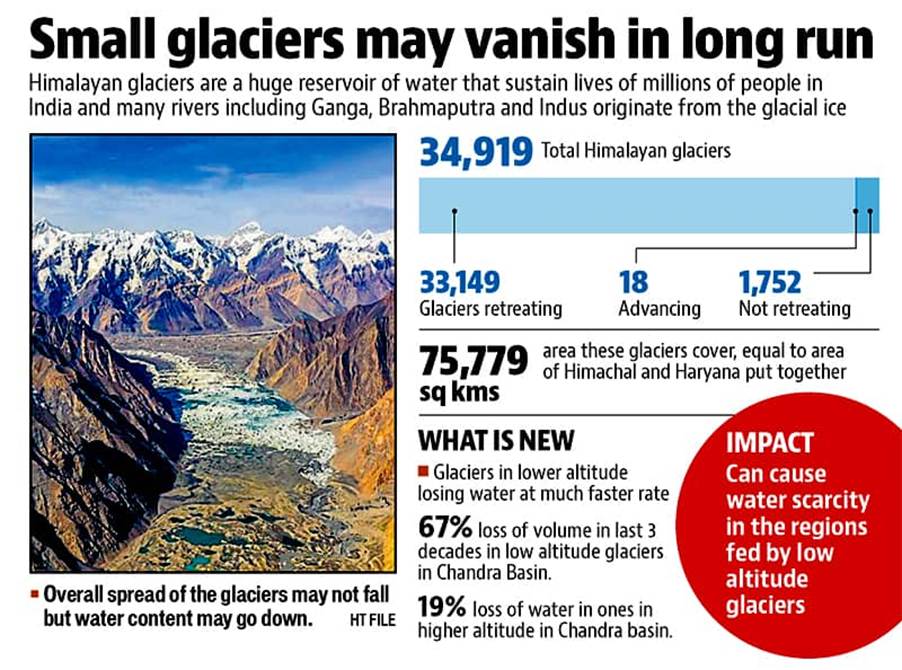
3. (b) Discuss the variations in nature of glaciers in India and the emerging issues due to climate change. 15Marks (PYQ/2024)
Answer:
Introduction
Glaciers in India—primarily in the Himalayan region—are critical components of the cryosphere, influencing regional hydrology and water security. These glaciers vary in type—from valley glaciers to debris-covered and hanging glaciers—and exhibit complex behaviors when viewed as dynamic systems. Under accelerating climate change, glacier dynamics are influenced by both external forcings (such as anthropogenic greenhouse gas emissions and global warming) and internal forcings (for example, local land-use changes and black carbon deposition). Systems analysis helps in understanding these interconnected factors and the positive feedback mechanisms that amplify glacier retreat and related hazards.

Variations in the Nature of Indian Glaciers
- Types and Characteristics:
- Valley Glaciers: Found in high mountain valleys (e.g., Gangotri Glacier), these glaciers accumulate snowfall and slowly flow, providing perennial meltwater during warmer months.
- Debris-Covered Glaciers: Present in regions like Sikkim, these glaciers are insulated by rock and sediment, which may initially slow melting but eventually result in unstable melting regimes.
- Hanging Glaciers: These are smaller, precariously perched on steep slopes and are extremely vulnerable to rapid disintegration.
- Hydrological Function and Systems Analysis: Glaciers form an integral part of the Indian hydrological system. Models like the Spatial Processes in Hydrology (SPHY) analyze the coupling between glacier mass balance and runoff. Systems analysis examines how glacier inputs, storage, ablation, and meltwater distribution collectively affect downstream water availability and ecosystem functioning.
Emerging Issues Due to Climate Change
- Climate Forcings:
- External Forcings: Global anthropogenic emissions increase atmospheric greenhouse gas concentrations, leading to higher overall temperatures. This external driver, as projected by IPCC models, significantly impacts the energy balance of glaciers.
- Internal Forcings: Local factors such as land-use changes, deforestation, and black carbon deposition on ice surfaces reduce albedo. Lower albedo increases solar absorption, thereby accelerating melting. Such internal forcings from the densely populated Himalayan fringes compound the warming effects.
- Positive Feedback Mechanisms: When temperatures rise, glaciers retreat, exposing darker underlying surfaces that absorb more heat. This reduction in albedo establishes a positive feedback loop: higher absorption leads to further warming and accelerated melting. This cycle intensifies the negative impact on glacier mass balance and alters hydrological regimes in regions dependent on meltwater.
- Risk of Glacial Lake Outburst Floods (GLOFs): As glaciers retreat, proglacial lakes form and expand. Without proper drainage, these lakes are prone to sudden outbursts, posing catastrophic risks to downstream communities. Models incorporating climate risk assessments predict an increased frequency and intensity of GLOF events in coming decades.
Legal, Theoretical, and Policy Perspectives
- Theoretical Models and Laws:
- Glacier Mass Balance Theory and Spatial Diffusion Models provide frameworks to understand accumulation–ablation dynamics and meltwater distribution.
- Internationally, regulatory frameworks like the Paris Agreement and national policies such as India’s National Action Plan on Climate Change guide mitigation and adaptation strategies.
- Perspectives: The environmental justice perspective emphasizes the vulnerability of Himalayan communities, while the sustainability perspective calls for integrated glacier monitoring and adaptation strategies.
Case Studies
- Gangotri Glacier (Uttarakhand): Research shows significant retreat of Gangotri over recent decades, with systems analysis revealing shifts in melt patterns affecting the Ganges’ flow.
- Dakshini Chamoli Glacial Lake (Uttarakhand): Rapid expansion of this lake has increased GLOF risks, prompting the development of early warning systems despite the challenges posed by rugged terrain and limited infrastructure.
Conclusion
Indian glaciers exhibit diverse characteristics and play a pivotal role in regional water management. However, external and internal climate forcings, coupled with positive feedback mechanisms, accelerate glacier retreat and pose significant risks. Integrated systems analysis, supported by theoretical models and legal frameworks, is essential to develop sustainable adaptation strategies that safeguard water security and local communities in the Himalayan region.
Tag:climate change and glaciers, emerging issues of climate change and glaciers in india, Geography Case Study, Geography Optional, geography optional case study, Geography Optional Pyq, geography optional pyq 2024, human geography, models theories laws and perspective in geography, variations in nature of glacires in india


